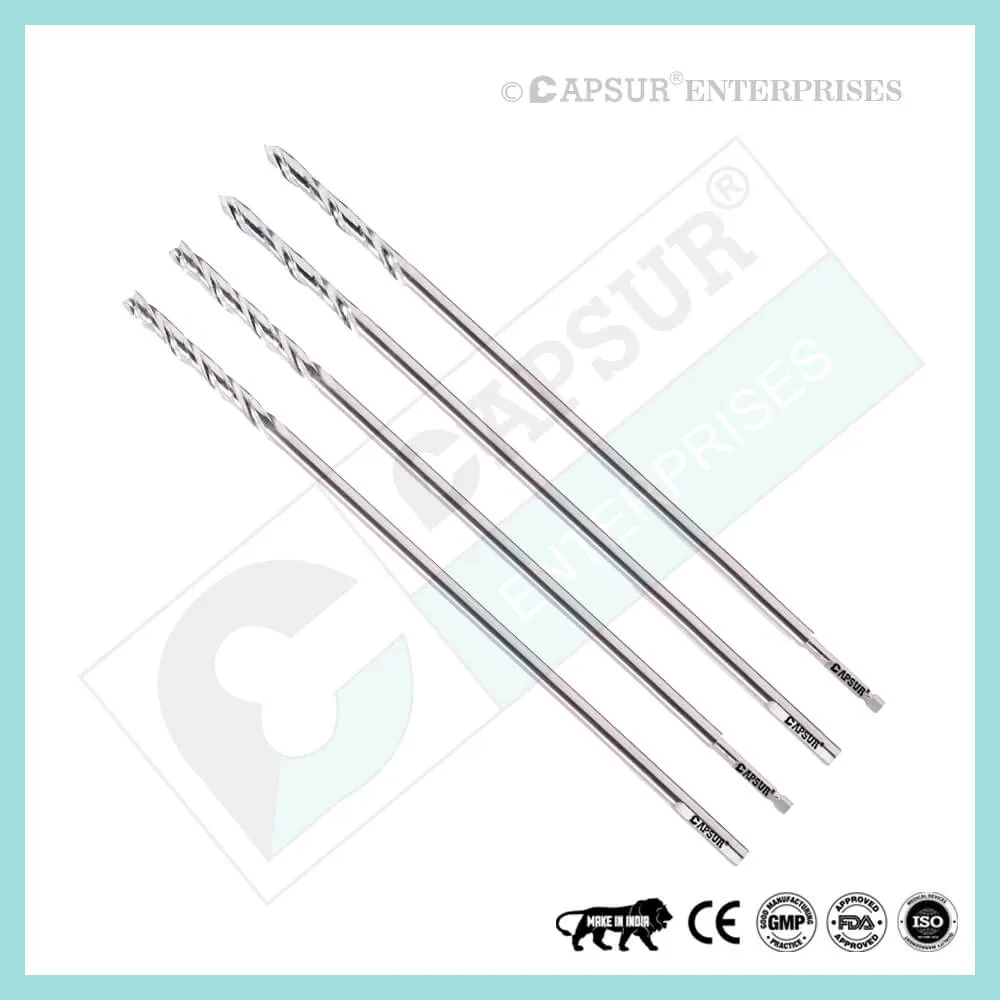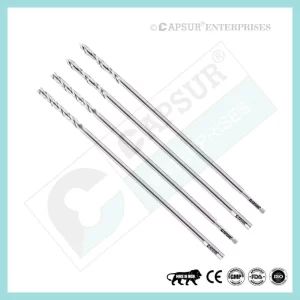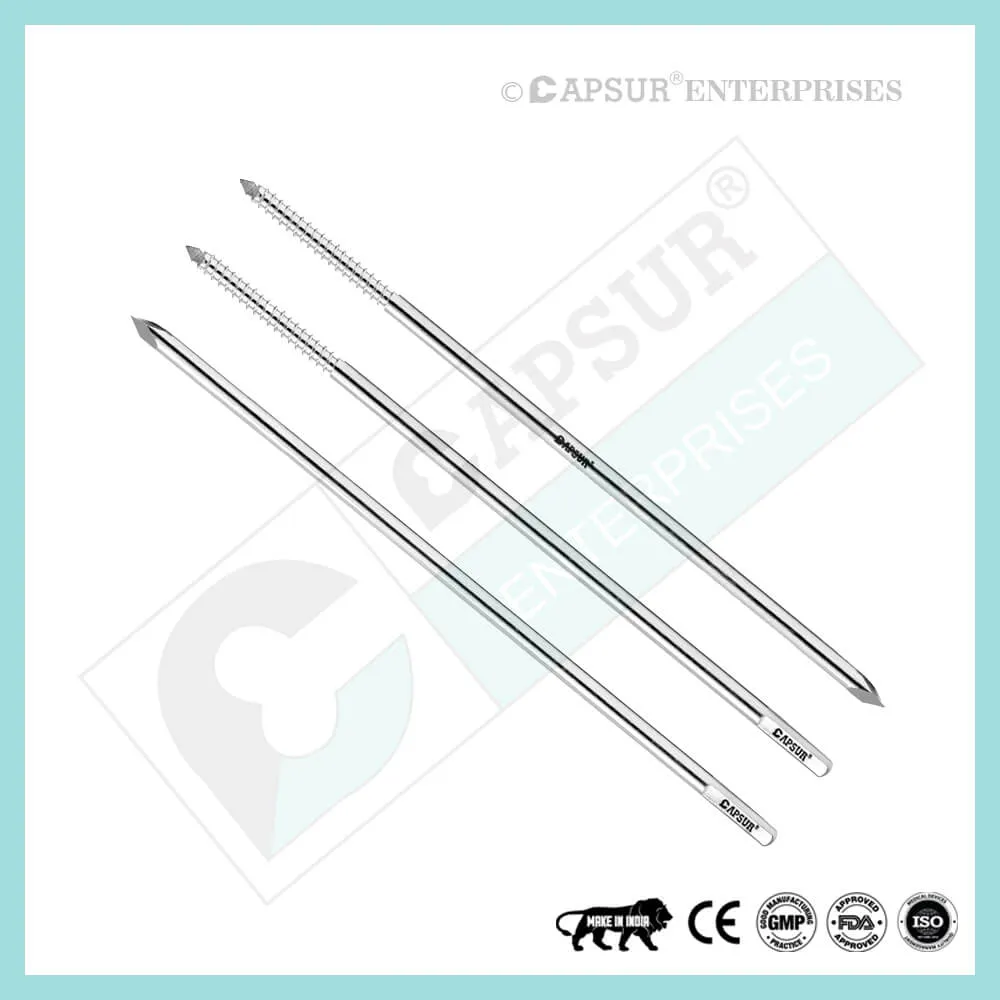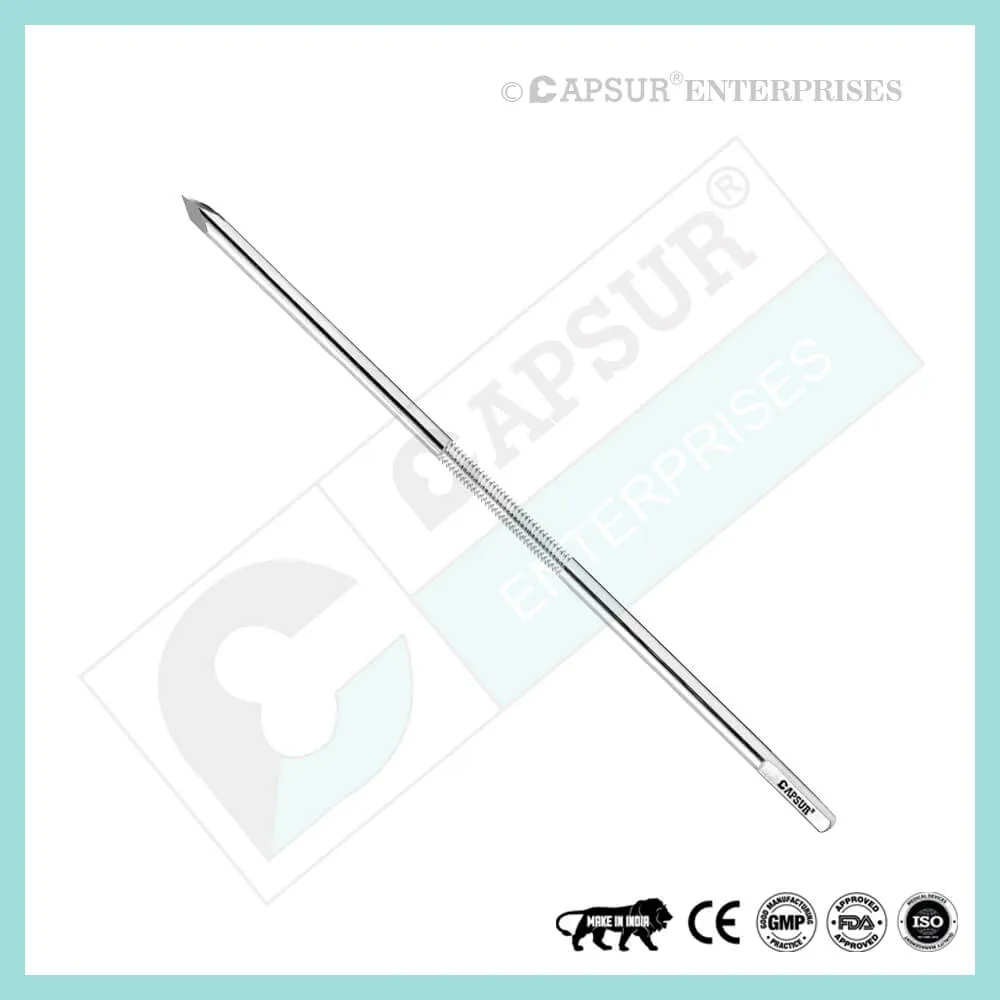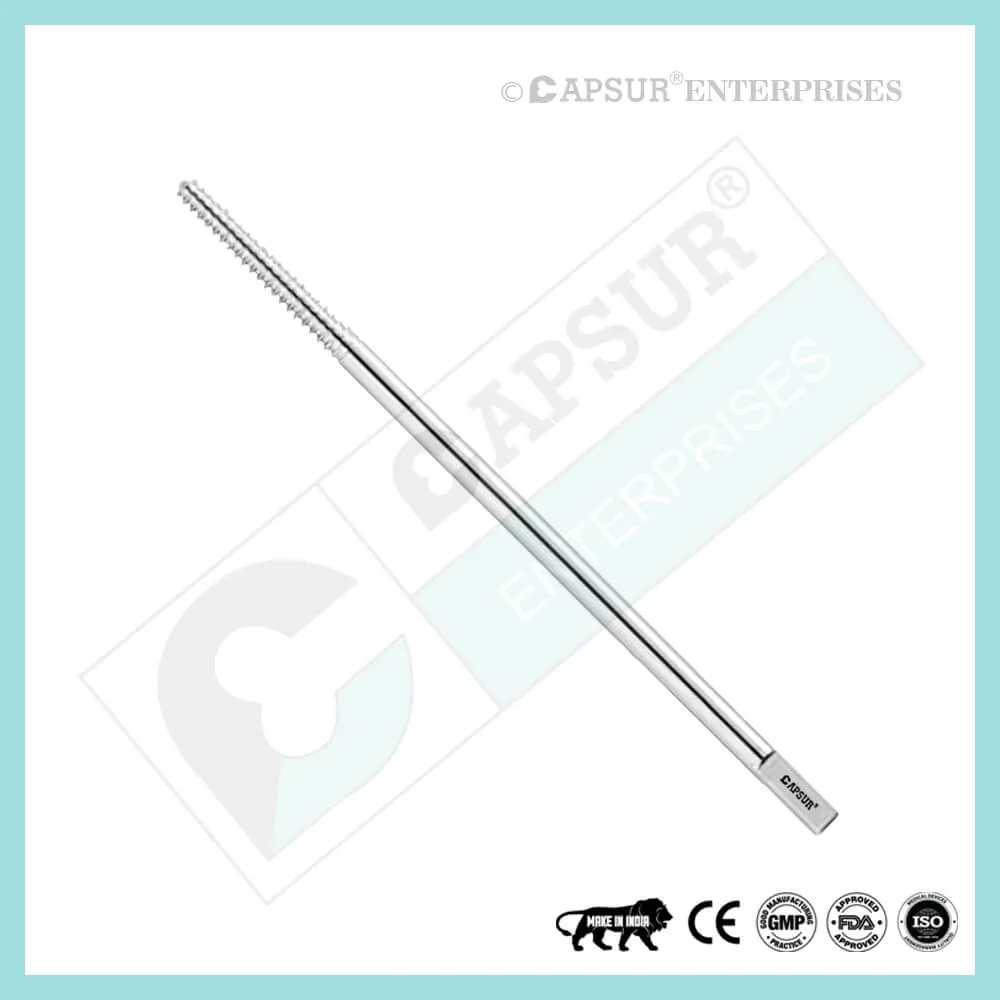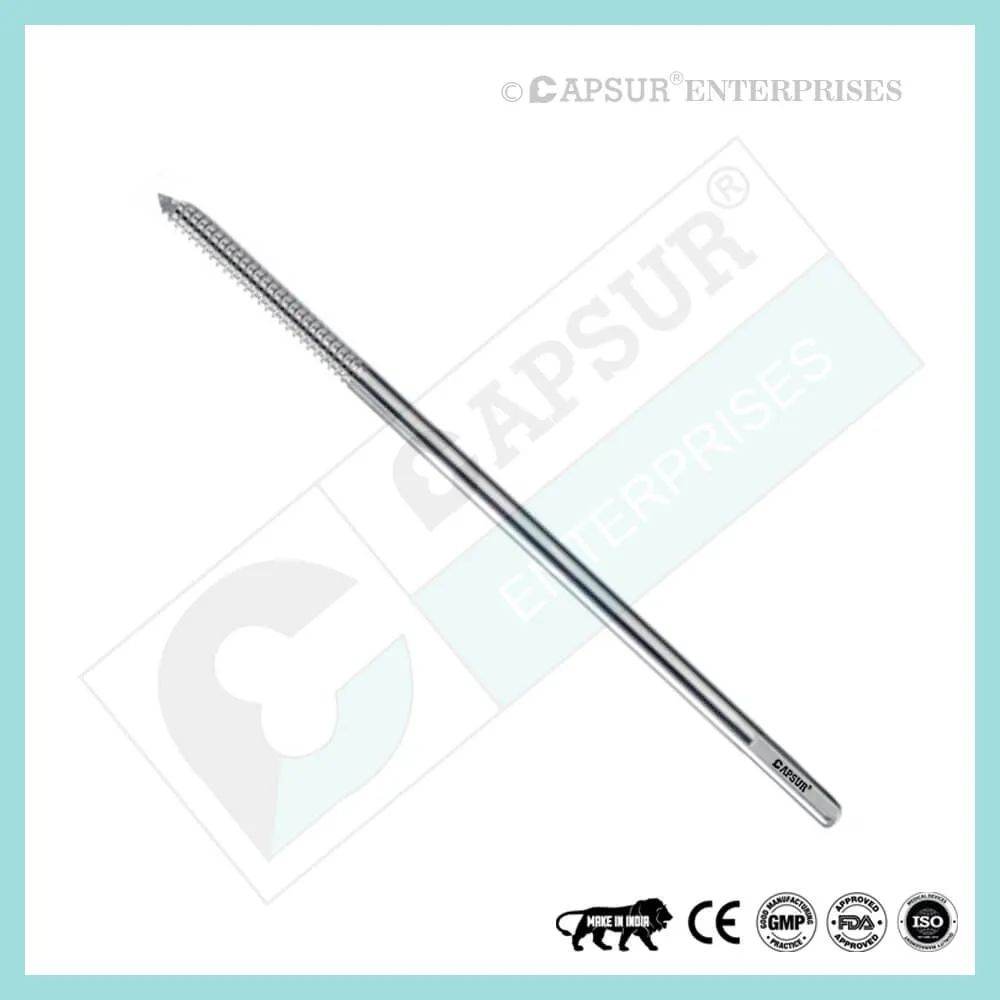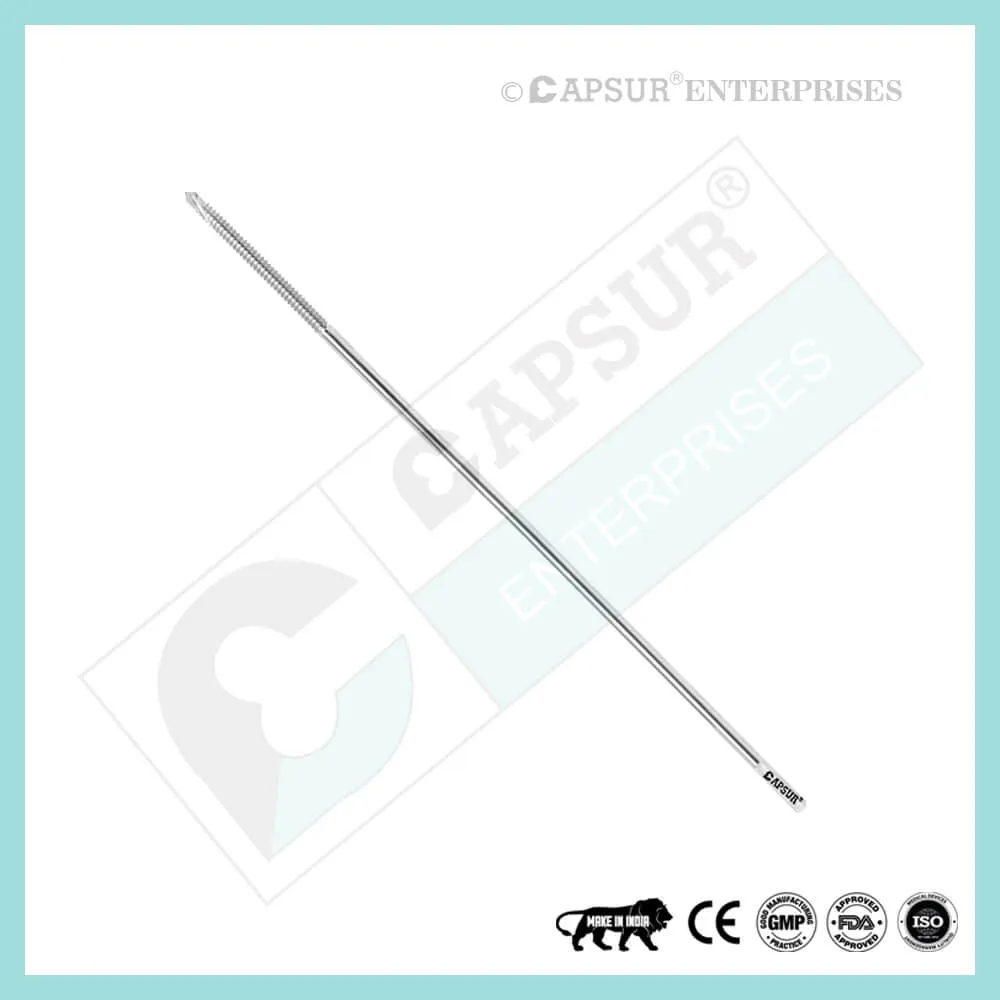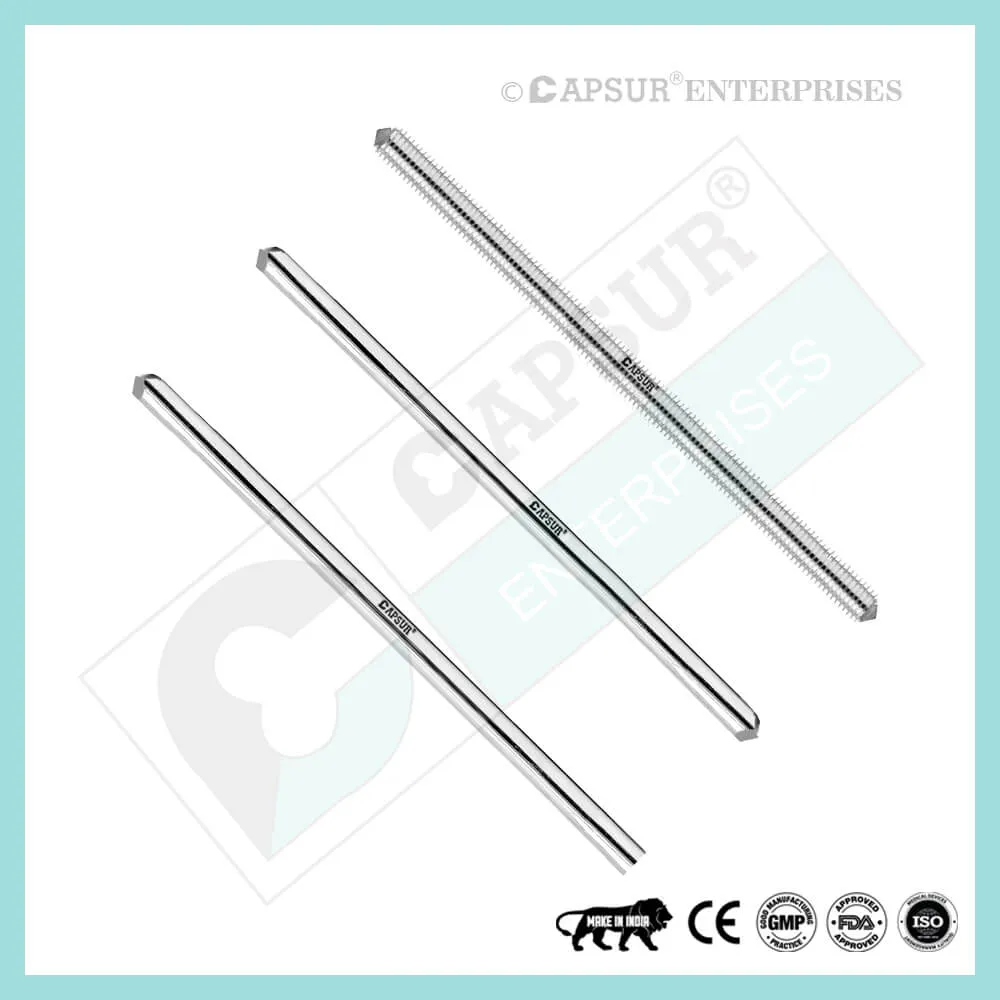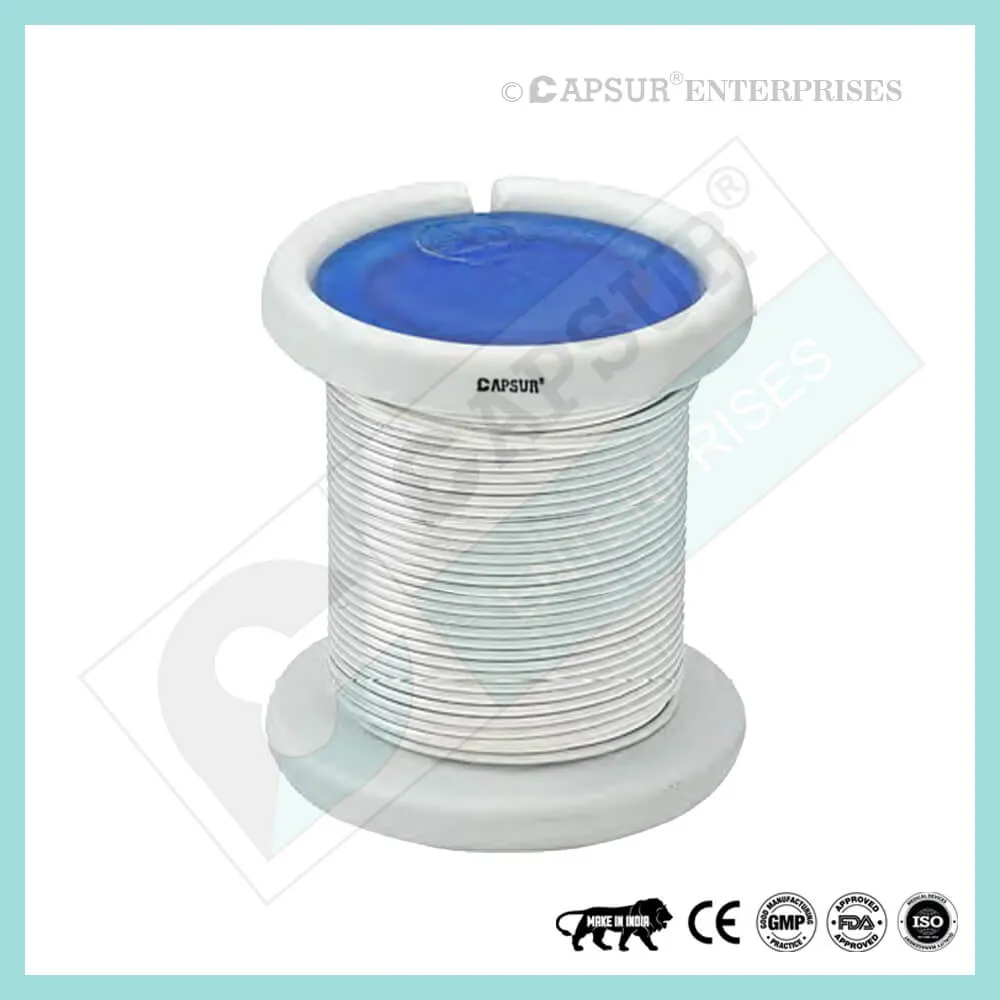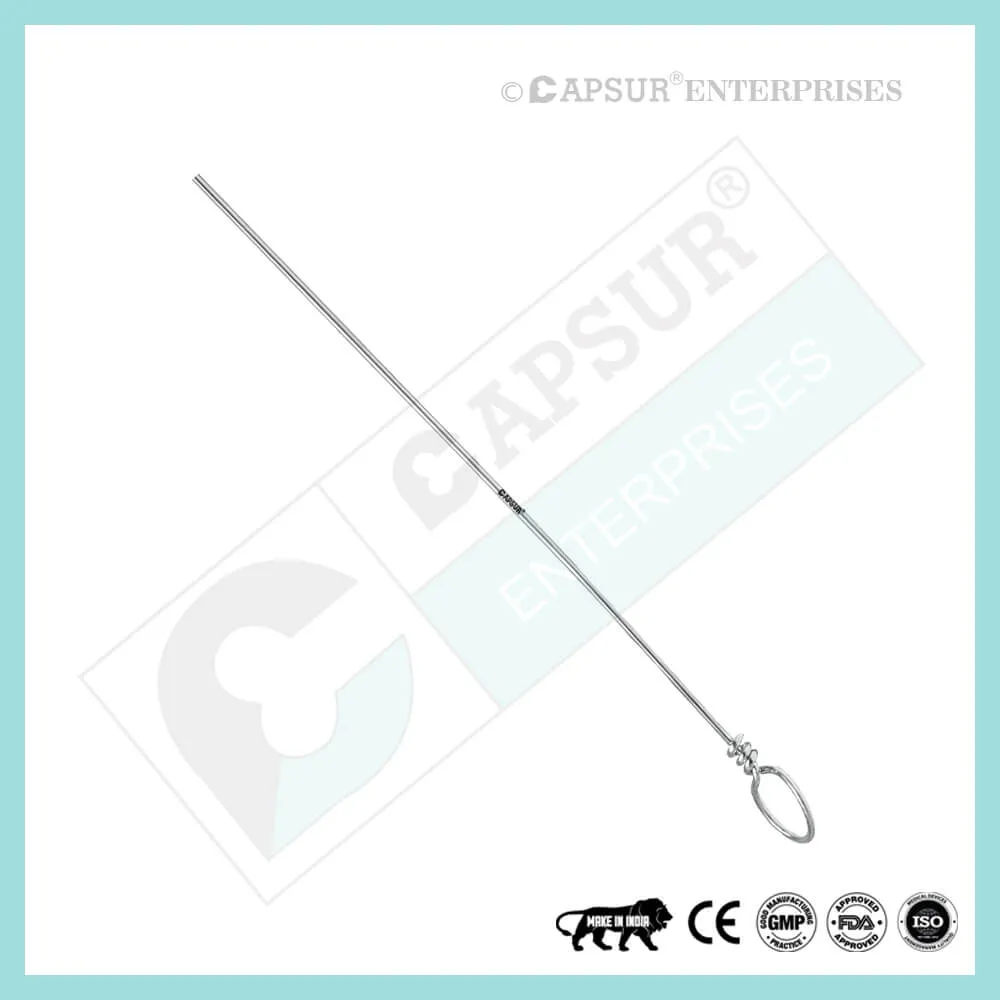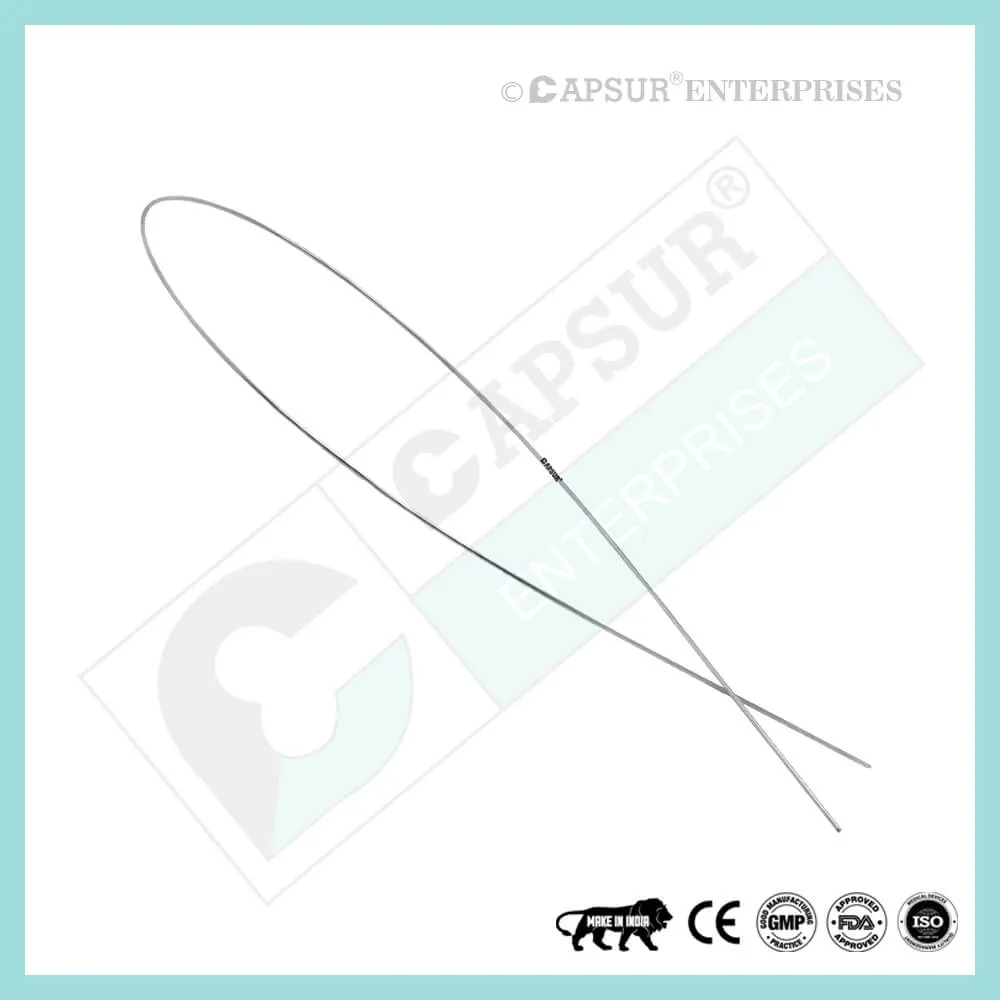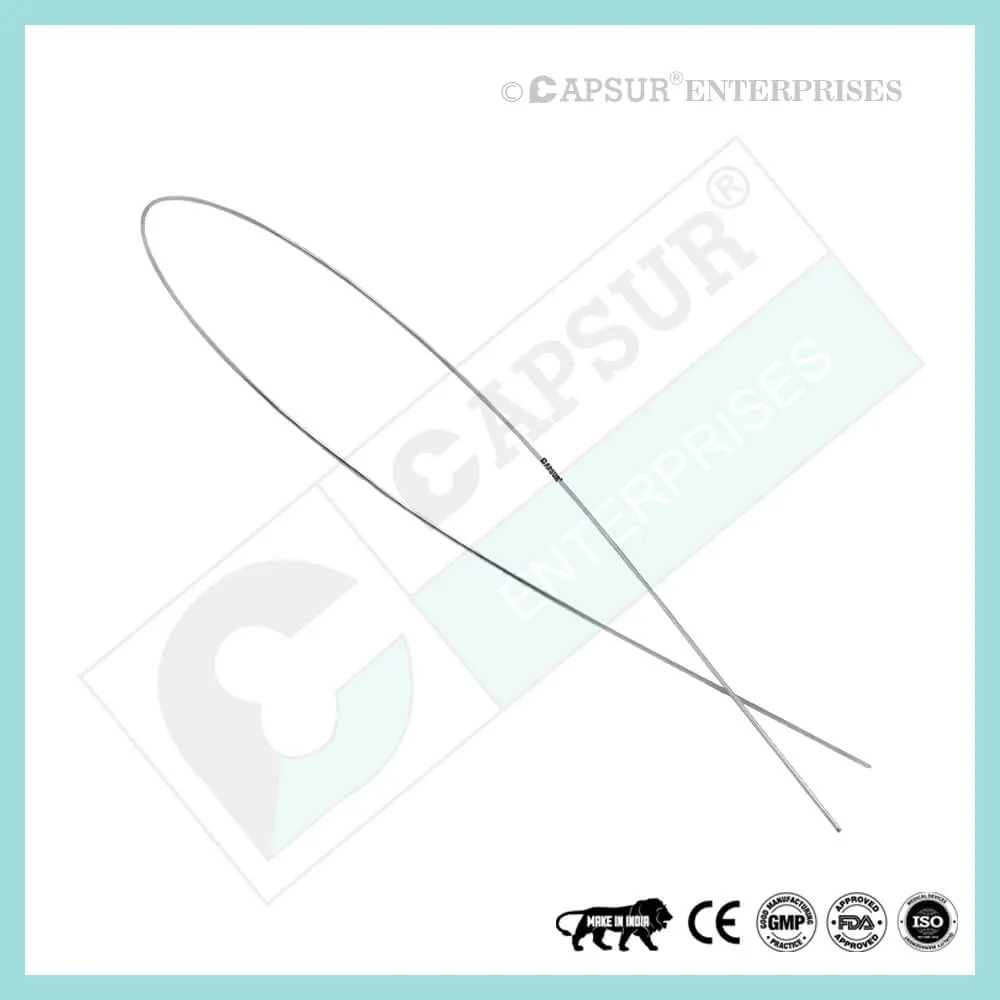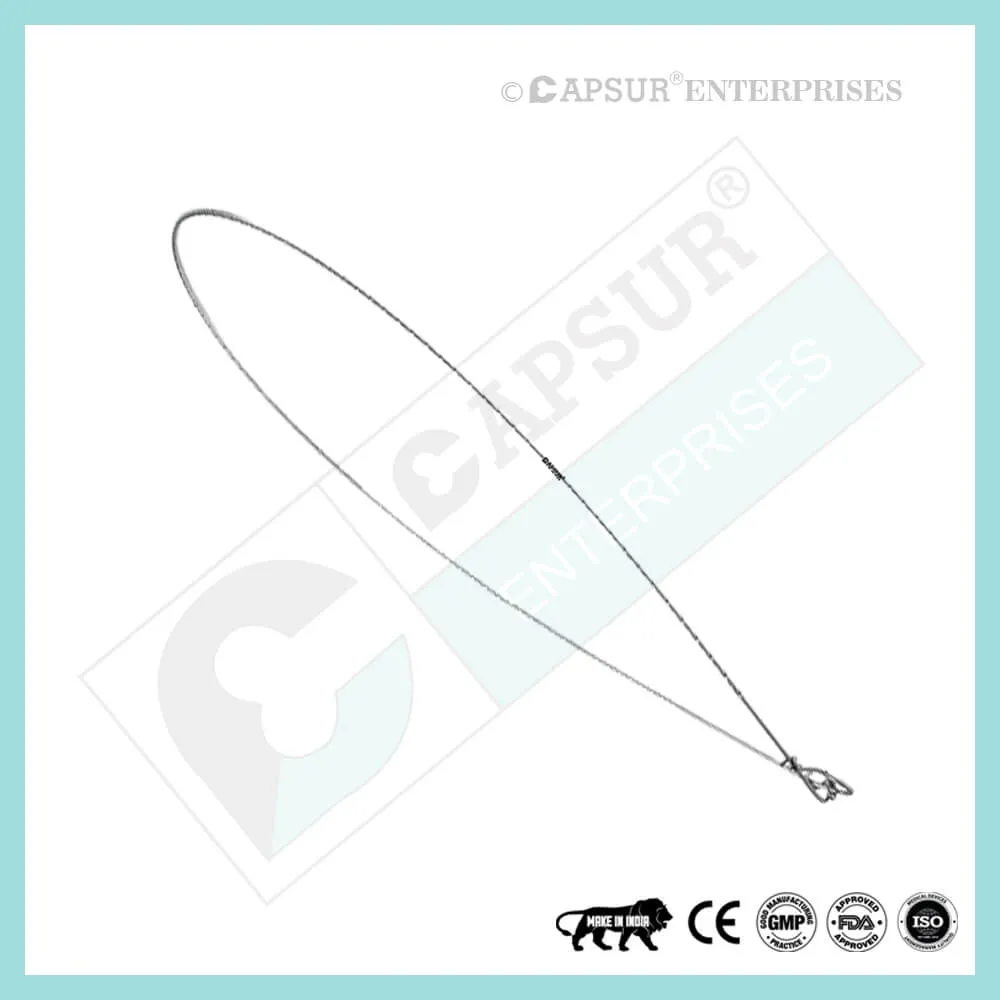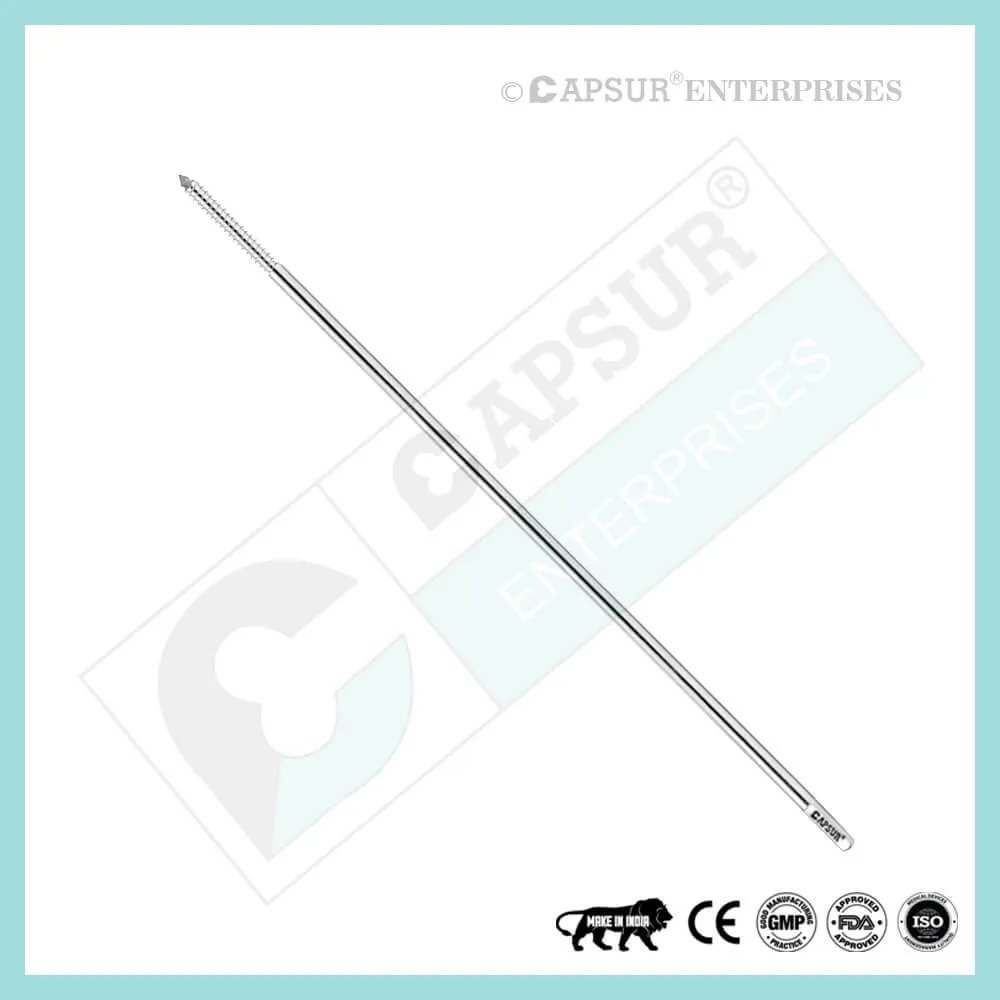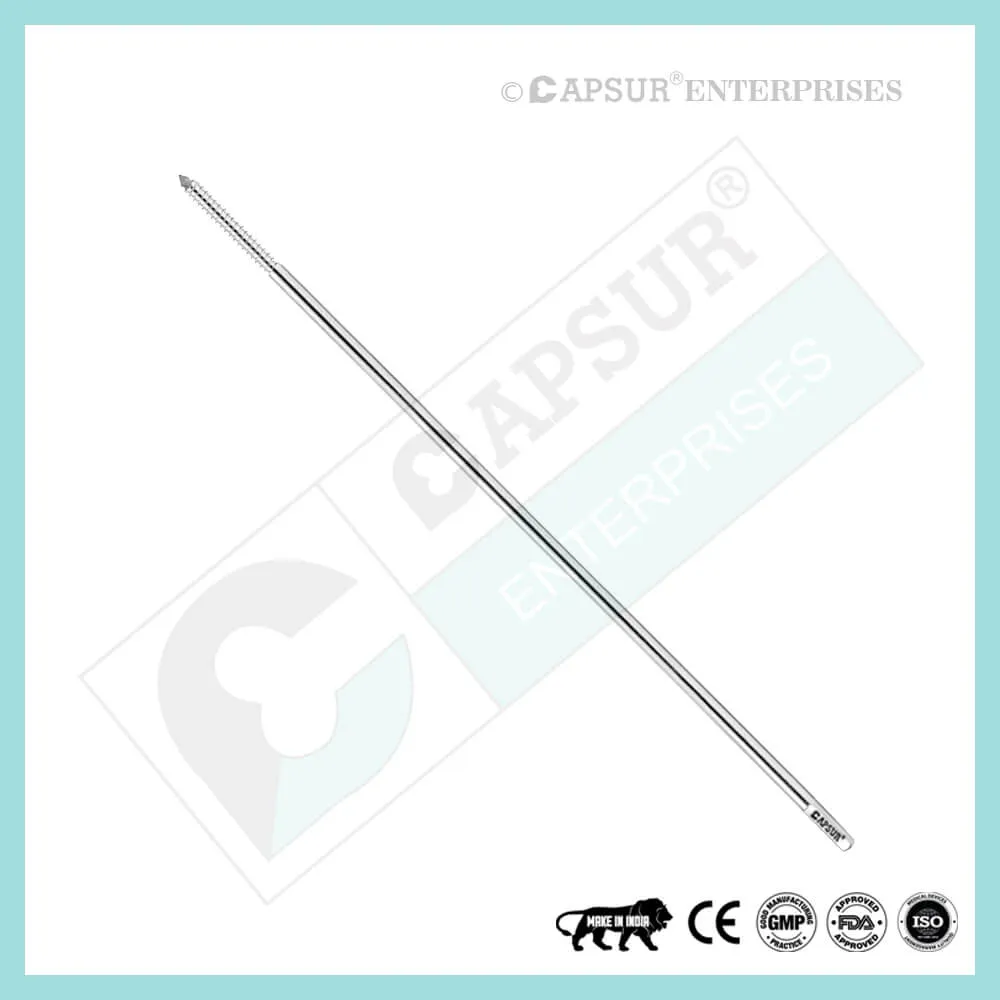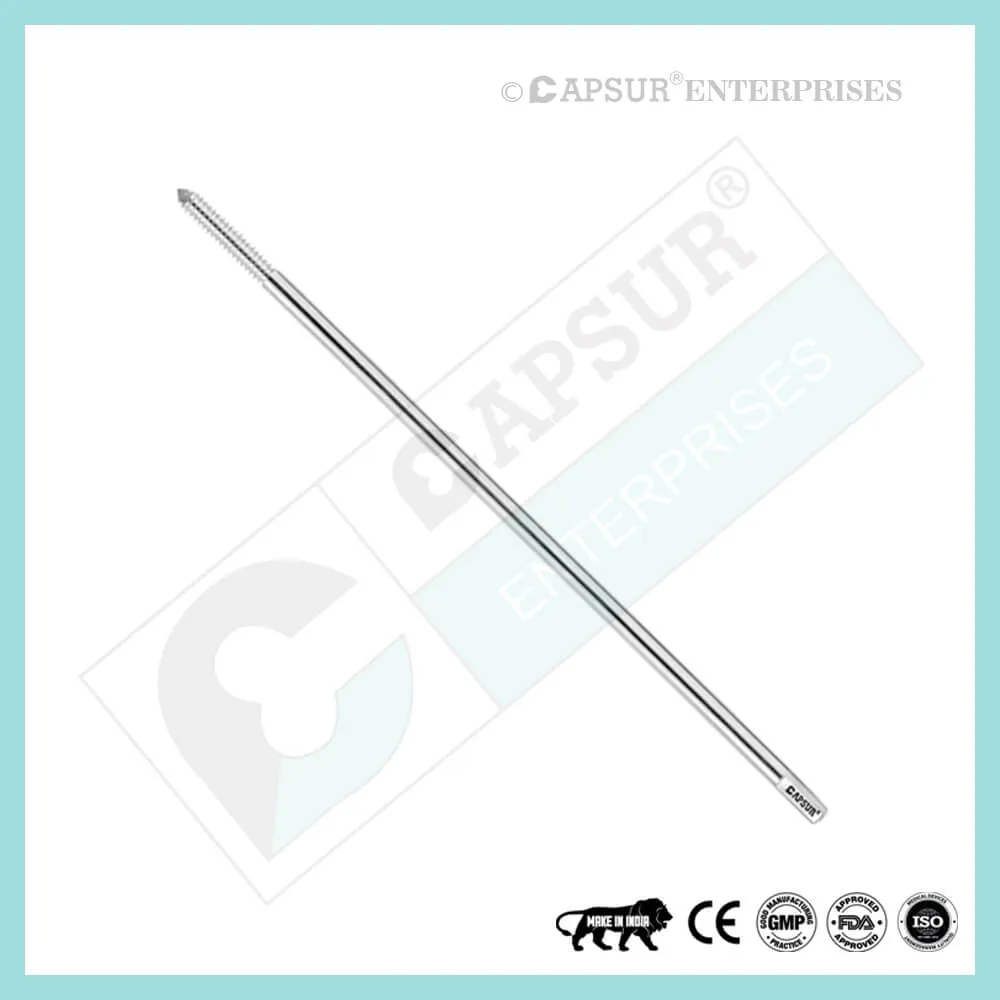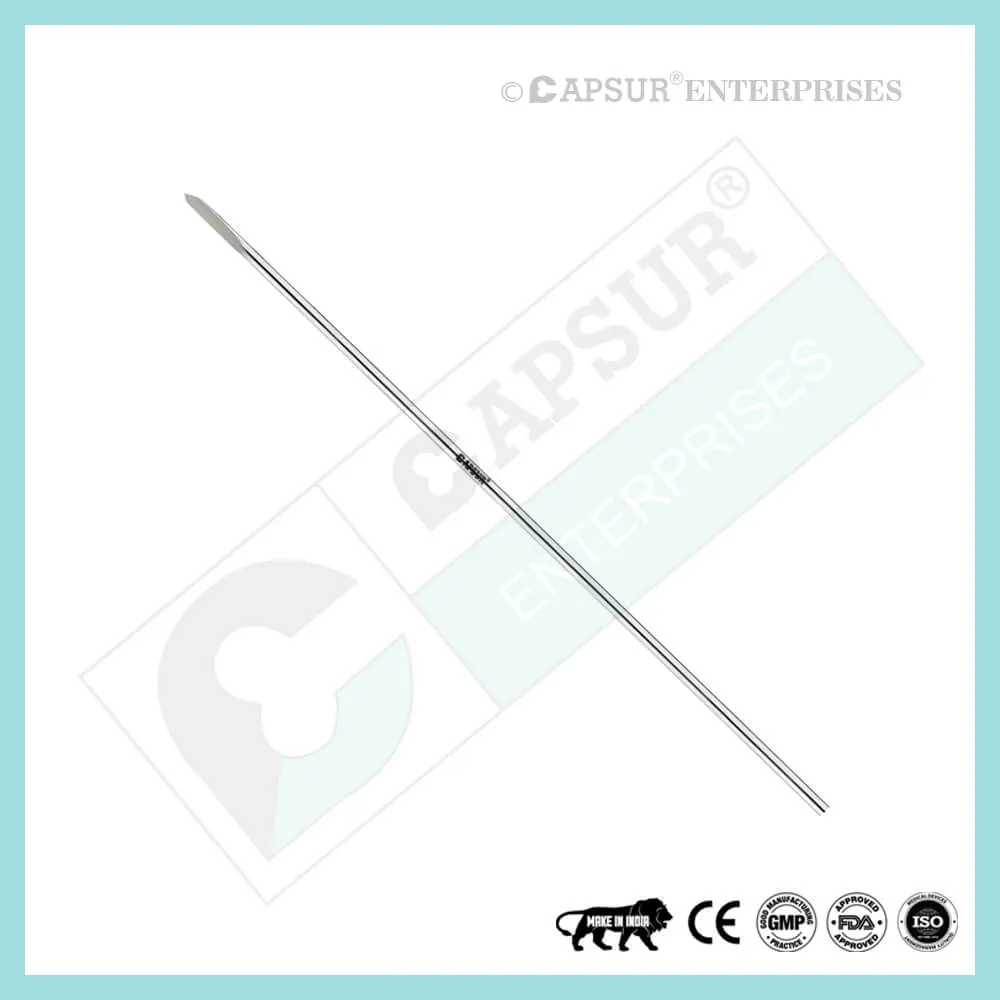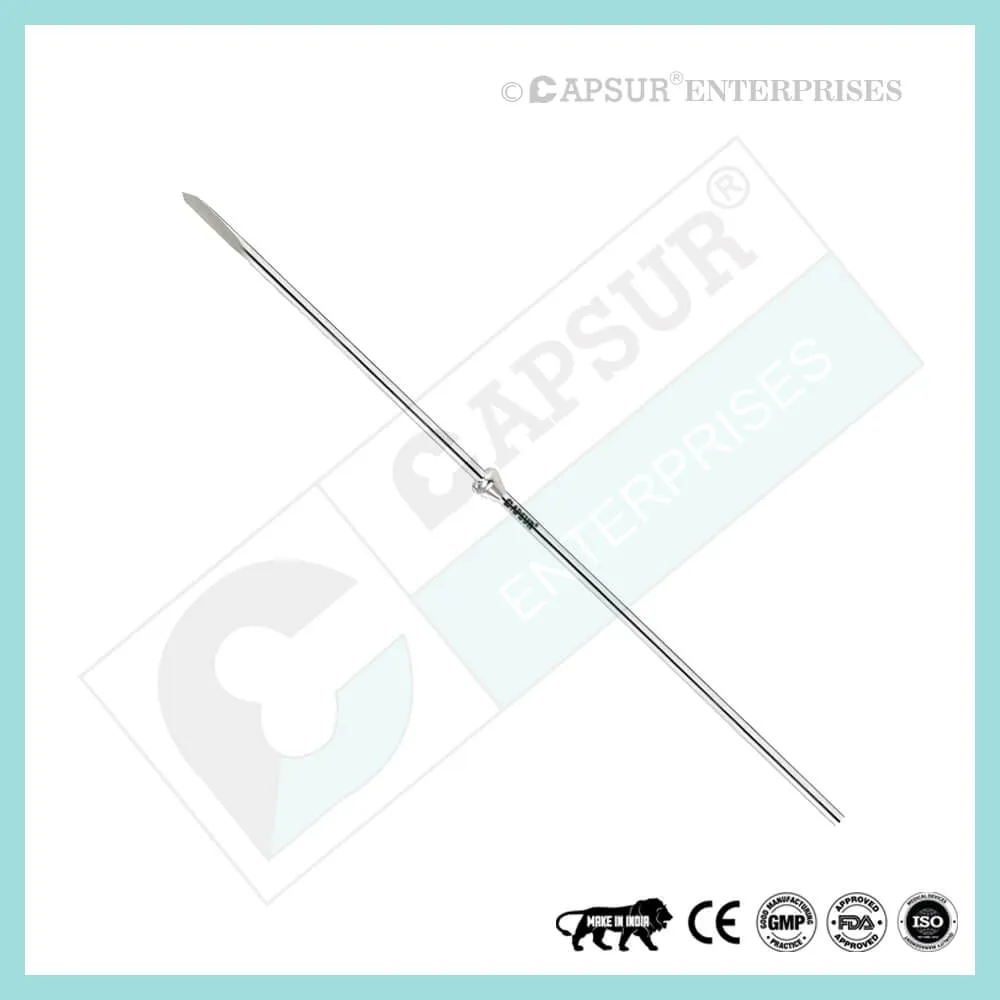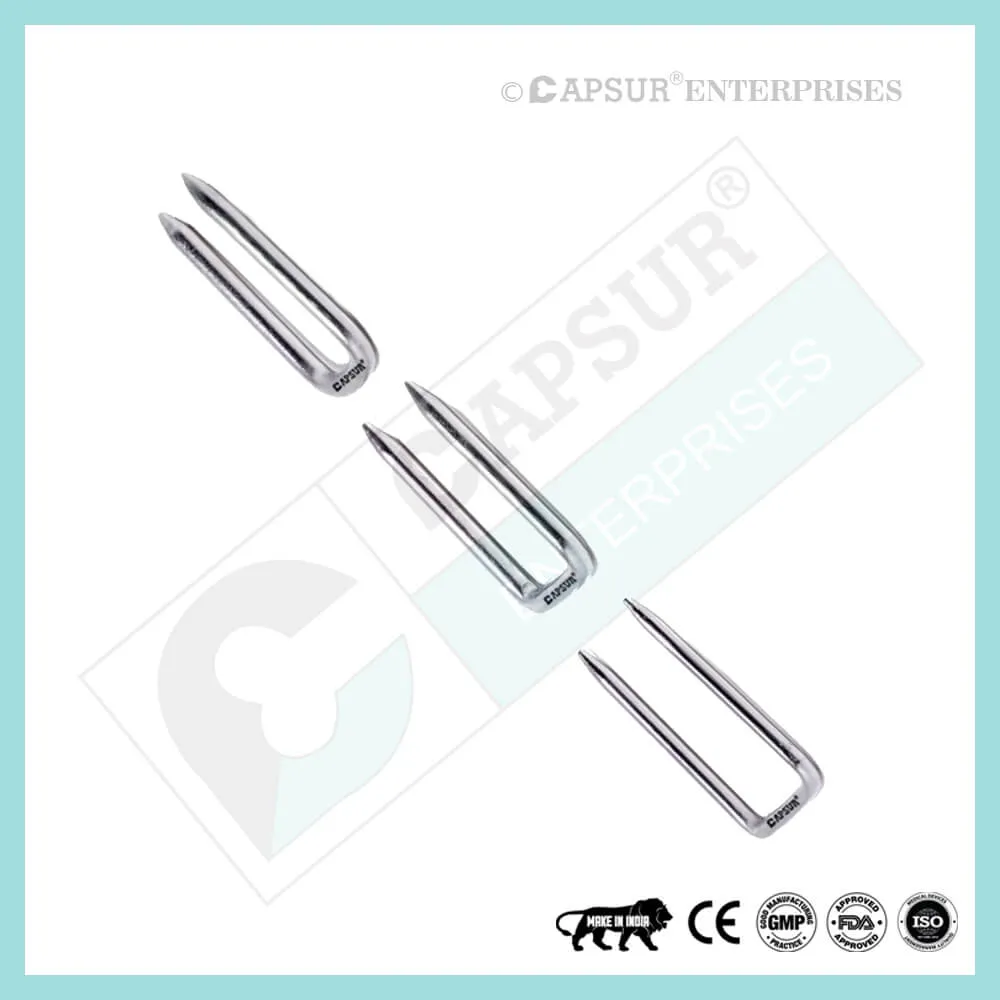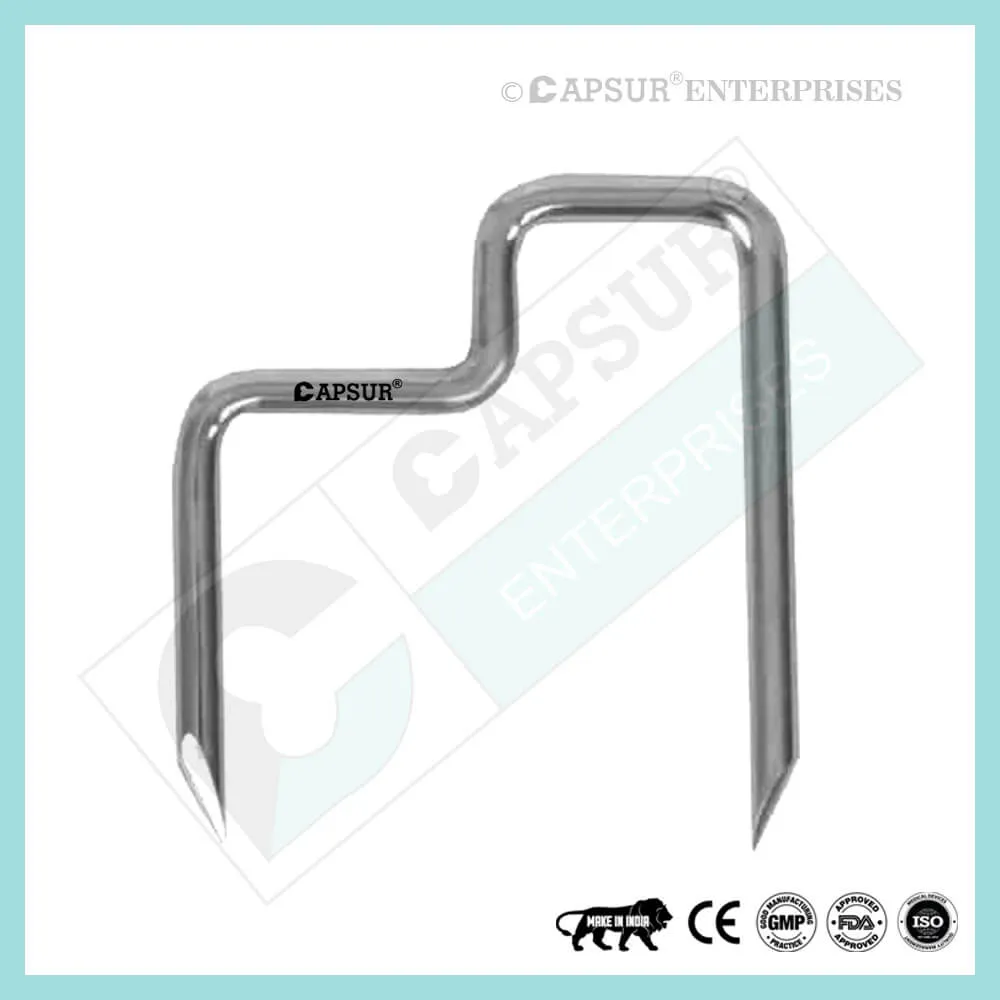Model No: 124433-A12
- Best Quality
- Affordable Pricing
- On-Time Delivery
- Customer Satisfaction
Specification for Drill Bits
- In order to fix bone plates with screws during orthopedic surgery, holes in the bone are made using surgical drill bits. In order to insert screws directly into the bone, holes can be drilled into the bone without the use of a plate.
- In order to simulate surgery, surgical drills use fewer steps and a more accurate method, saving time. Modern surgical drill bits enable accurate measurement from the topmost layer of skin to the tip of the drill sleeve, which can be determined directly from the drill bit.
- Surgical stainless steel of the highest quality is used to create our drill bits. These drill bits are resistant to rust and can be sterilized and used repeatedly.
- Surgical drill bits come in a variety of shapes, sizes, and lengths.
- Cannulated Plain Shank, Cannulated Quick Copuling, Solid Plain Shank, and others
- 1 mm to 5 mm in diameter
- 60 mm to 250 mm in length
Uses of Drill Bits
- During orthopedic surgery, surgical drill bits are used to create holes in the bone so that bone plates can be fixed with screws. Sometimes holes are drilled into the bone to accommodate the insertion of screws without a plate.
- Treatment for bone fractures typically involves immobilizing the fractured parts until healing takes place while returning them to their original positions. To fix broken parts for immobilization, surgical drill bits are frequently used to create holes in bone. Orthopaedic drilling increases bone temperature and forces during surgery, which can occasionally result in osteonecrosis and lessen the stability and strength of the fixation.
Other Important Info of Drill Bits
Surgical Drill Bits Sizes
- Solid Plain Shank Surgical Drill Bits Sizes
- Solid, Plain Shank (Dia x Length) : 1 mm x 60 mm
- Solid, Plain Shank (Dia x Length) : 1.1 mm x 60 mm
- Solid, Plain Shank (Dia x Length) : 1.2 mm x 60 mm
- Solid, Plain Shank (Dia x Length) : 1.5 mm x 80 mm
- Solid, Plain Shank (Dia x Length) : 2 mm x 100 mm
- Solid, Plain Shank (Dia x Length) : 2.2 mm x 100 mm
- Solid, Plain Shank (Dia x Length) : 2.4 mm x 100 mm
- Solid, Plain Shank (Dia x Length) : 2.5 mm x 120 mm
- Solid, Plain Shank (Dia x Length) : 2.7 mm x 100 mm
- Solid, Plain Shank (Dia x Length) : 2.7 mm x 130 mm
- Solid, Plain Shank (Dia x Length) : 2.7 mm x 150 mm
- Solid, Plain Shank (Dia x Length) : 2.8 mm x 170 mm
- Solid, Plain Shank (Dia x Length) : 3.2 mm x 130 mm
- Solid, Plain Shank (Dia x Length) : 3.2 mm x 150 mm
- Solid, Plain Shank (Dia x Length) : 3.2 mm x 200 mm
- Solid, Plain Shank (Dia x Length) : 3.2 mm x 230 mm
- Solid, Plain Shank (Dia x Length) : 3.2 mm x 250 mm
- Solid, Plain Shank (Dia x Length) : 3.5 mm x 130 mm
- Solid, Plain Shank (Dia x Length) : 3.5 mm x 150 mm
- Solid, Plain Shank (Dia x Length) : 3.5 mm x 200 mm
- Solid, Plain Shank (Dia x Length) : 3.5 mm x 230 mm
- Solid, Plain Shank (Dia x Length) : 3.5 mm x 250 mm
- Solid, Plain Shank (Dia x Length) : 4 mm x 200 mm
- Solid, Plain Shank (Dia x Length) : 4 mm x 230 mm
- Solid, Plain Shank (Dia x Length) : 4 mm x 250 mm
- Solid, Plain Shank (Dia x Length) : 4.3 mm x 230 mm
- Solid, Plain Shank (Dia x Length) : 4.5 mm x 130 mm
- Solid, Plain Shank (Dia x Length) : 4.5 mm x 150 mm
- Solid, Plain Shank (Dia x Length) : 4.5 mm x 200 mm
- Solid, Plain Shank (Dia x Length) : 4.5 mm x 230 mm
- Solid, Plain Shank (Dia x Length) : 5 mm x 200 mm
- Solid, Plain Shank (Dia x Length) : 5 mm x 250 mm
Solid Quick Copuling Surgical Drill Bits Sizes
- Solid, Quick Copuling (Dia x Length) : 1 mm x 60 mm
- Solid, Quick Copuling (Dia x Length) : 1.1 mm x 60 mm
- Solid, Quick Copuling (Dia x Length) : 1.2 mm x 60 mm
- Solid, Quick Copuling (Dia x Length) : 1.5 mm x 80 mm
- Solid, Quick Copuling (Dia x Length) : 2 mm x 100 mm
- Solid, Quick Copuling (Dia x Length) : 2.2 mm x 100 mm
- Solid, Quick Copuling (Dia x Length) : 2.4 mm x 100 mm
- Solid, Quick Copuling (Dia x Length) : 2.5 mm x 120 mm
- Solid, Quick Copuling (Dia x Length) : 2.7 mm x 100 mm
- Solid, Quick Copuling (Dia x Length) : 2.7 mm x 130 mm
- Solid, Quick Copuling (Dia x Length) : 2.7 mm x 150 mm
- Solid, Quick Copuling (Dia x Length) : 2.8 mm x 170 mm
- Solid, Quick Copuling (Dia x Length) : 3.2 mm x 130 mm
- Solid, Quick Copuling (Dia x Length) : 3.2 mm x 150 mm
- Solid, Quick Copuling (Dia x Length) : 3.2 mm x 200 mm
- Solid, Quick Copuling (Dia x Length) : 3.2 mm x 230 mm
- Solid, Quick Copuling (Dia x Length) : 3.2 mm x 250 mm
- Solid, Quick Copuling (Dia x Length) : 3.5 mm x 130 mm
- Solid, Quick Copuling (Dia x Length) : 3.5 mm x 150 mm
- Solid, Quick Copuling (Dia x Length) : 3.5 mm x 200 mm
- Solid, Quick Copuling (Dia x Length) : 3.5 mm x 230 mm
- Solid, Quick Copuling (Dia x Length) : 3.5 mm x 250 mm
- Solid, Quick Copuling (Dia x Length) : 4 mm x 200 mm
- Solid, Quick Copuling (Dia x Length) : 4 mm x 230 mm
- Solid, Quick Copuling (Dia x Length) : 4 mm x 250 mm
- Solid, Quick Copuling (Dia x Length) : 4.3 mm x 230 mm
- Solid, Quick Copuling (Dia x Length) : 4.5 mm x 130 mm
- Solid, Quick Copuling (Dia x Length) : 4.5 mm x 150 mm
- Solid, Quick Copuling (Dia x Length) : 4.5 mm x 200 mm
- Solid, Quick Copuling (Dia x Length) : 4.5 mm x 230 mm
- Solid, Quick Copuling (Dia x Length) : 5 mm x 200 mm
- Solid, Quick Copuling (Dia x Length) : 5 mm x 250 mm
Cannulated Plain Shank Surgical Drill Bits Sizes
- Cannulated, Plain Shank (Dia x Length) : 1 mm x 60 mm
- Cannulated, Plain Shank (Dia x Length) : 1.1 mm x 60 mm
- Cannulated, Plain Shank (Dia x Length) : 1.2 mm x 60 mm
- Cannulated, Plain Shank (Dia x Length) : 1.5 mm x 80 mm
- Cannulated, Plain Shank (Dia x Length) : 2 mm x 100 mm
- Cannulated, Plain Shank (Dia x Length) : 2.2 mm x 100 mm
- Cannulated, Plain Shank (Dia x Length) : 2.4 mm x 100 mm
- Cannulated, Plain Shank (Dia x Length) : 2.5 mm x 120 mm
- Cannulated, Plain Shank (Dia x Length) : 2.7 mm x 100 mm
- Cannulated, Plain Shank (Dia x Length) : 2.7 mm x 130 mm
- Cannulated, Plain Shank (Dia x Length) : 2.7 mm x 150 mm
- Cannulated, Plain Shank (Dia x Length) : 2.8 mm x 170 mm
- Cannulated, Plain Shank (Dia x Length) : 3.2 mm x 130 mm
- Cannulated, Plain Shank (Dia x Length) : 3.2 mm x 150 mm
- Cannulated, Plain Shank (Dia x Length) : 3.2 mm x 200 mm
- Cannulated, Plain Shank (Dia x Length) : 3.2 mm x 230 mm
- Cannulated, Plain Shank (Dia x Length) : 3.2 mm x 250 mm
- Cannulated, Plain Shank (Dia x Length) : 3.5 mm x 130 mm
- Cannulated, Plain Shank (Dia x Length) : 3.5 mm x 150 mm
- Cannulated, Plain Shank (Dia x Length) : 3.5 mm x 200 mm
- Cannulated, Plain Shank (Dia x Length) : 3.5 mm x 230 mm
- Cannulated, Plain Shank (Dia x Length) : 3.5 mm x 250 mm
- Cannulated, Plain Shank (Dia x Length) : 4 mm x 200 mm
- Cannulated, Plain Shank (Dia x Length) : 4 mm x 230 mm
- Cannulated, Plain Shank (Dia x Length) : 4 mm x 250 mm
- Cannulated, Plain Shank (Dia x Length) : 4.3 mm x 230 mm
- Cannulated, Plain Shank (Dia x Length) : 4.5 mm x 130 mm
- Cannulated, Plain Shank (Dia x Length) : 4.5 mm x 150 mm
- Cannulated, Plain Shank (Dia x Length) : 4.5 mm x 200 mm
- Cannulated, Plain Shank (Dia x Length) : 4.5 mm x 230 mm
- Cannulated, Plain Shank (Dia x Length) : 5 mm x 200 mm
- Cannulated, Plain Shank (Dia x Length) : 5 mm x 250 mm
Cannulated Quick Copuling Surgical Drill Bits Sizes
- Cannulated, Quick Copuling (Dia x Length) : 1 mm x 60 mm
- Cannulated, Quick Copuling (Dia x Length) : 1.1 mm x 60 mm
- Cannulated, Quick Copuling (Dia x Length) : 1.2 mm x 60 mm
- Cannulated, Quick Copuling (Dia x Length) : 1.5 mm x 80 mm
- Cannulated, Quick Copuling (Dia x Length) : 2 mm x 100 mm
- Cannulated, Quick Copuling (Dia x Length) : 2.2 mm x 100 mm
- Cannulated, Quick Copuling (Dia x Length) : 2.4 mm x 100 mm
- Cannulated, Quick Copuling (Dia x Length) : 2.5 mm x 120 mm
- Cannulated, Quick Copuling (Dia x Length) : 2.7 mm x 100 mm
- Cannulated, Quick Copuling (Dia x Length) : 2.7 mm x 130 mm
- Cannulated, Quick Copuling (Dia x Length) : 2.7 mm x 150 mm
- Cannulated, Quick Copuling (Dia x Length) : 2.8 mm x 170 mm
- Cannulated, Quick Copuling (Dia x Length) : 3.2 mm x 130 mm
- Cannulated, Quick Copuling (Dia x Length) : 3.2 mm x 150 mm
- Cannulated, Quick Copuling (Dia x Length) : 3.2 mm x 200 mm
- Cannulated, Quick Copuling (Dia x Length) : 3.2 mm x 230 mm
- Cannulated, Quick Copuling (Dia x Length) : 3.2 mm x 250 mm
- Cannulated, Quick Copuling (Dia x Length) : 3.5 mm x 130 mm
- Cannulated, Quick Copuling (Dia x Length) : 3.5 mm x 150 mm
- Cannulated, Quick Copuling (Dia x Length) : 3.5 mm x 200 mm
- Cannulated, Quick Copuling (Dia x Length) : 3.5 mm x 230 mm
- Cannulated, Quick Copuling (Dia x Length) : 3.5 mm x 250 mm
- Cannulated, Quick Copuling (Dia x Length) : 4 mm x 200 mm
- Cannulated, Quick Copuling (Dia x Length) : 4 mm x 230 mm
- Cannulated, Quick Copuling (Dia x Length) : 4 mm x 250 mm
- Cannulated, Quick Copuling (Dia x Length) : 4.3 mm x 230 mm
- Cannulated, Quick Copuling (Dia x Length) : 4.5 mm x 130 mm
- Cannulated, Quick Copuling (Dia x Length) : 4.5 mm x 150 mm
- Cannulated, Quick Copuling (Dia x Length) : 4.5 mm x 200 mm
- Cannulated, Quick Copuling (Dia x Length) : 4.5 mm x 230 mm
- Cannulated, Quick Copuling (Dia x Length) : 5 mm x 200 mm
- Cannulated, Quick Copuling (Dia x Length) : 5 mm x 250 mm
Surgical Drill Bits Risk Factor
When assessing the prognosis in each case, contraindications—which may be partial or complete—must be taken into account. Under the following circumstances, alternative management strategies may need to be taken into account:
- infections that are systemic or local, acute or chronic.
- either localized, systemic, or chronic inflammation.
- serve as a dangerous vascular, nervous, or muscular disease.
- Bone defects that would prevent the implant from being properly anchored.
- All associated illnesses that might jeopardize the implant’s success and functionality.
Warnings and Precautionary for Surgical Drill Bits
Before using Surgical Drill Bits, the surgeon and supporting personnel should read the safety instructions in this document as well as any product-specific information in the product description, surgical techniques, and/or brochures.
Drill Bits are designed, built, and produced with the utmost care using materials of the highest quality for medical use. If used properly, these high-quality drill bits guarantee the best working outcomes. The usage guidelines and safety advice that are provided below must be followed.
Drill Bit misuse can result in tissue damage, premature wear and tear, instrument destruction, as well as injury to the user, patients, or other people.
It is essential that the operating surgeon actively participate in the medical care of their patients. All facets of the surgical procedure and the tools used, including their limitations, should be fully understood by the surgeon. It is the surgeon’s and the surgical team’s responsibility to take care in the selection and use of surgical instruments. Prior to using implants, sufficient surgical training must be obtained.
The following variables could harm the operation’s success:
- implanted material allergies.
- specific bone tumors.
- both osteoporosis and osteomalacia.
- disordered metabolism and systemic disease.
- abuse of drugs and alcohol.
- The implant is exposed to blows and/or excessive loading during physical activities that involve strong shocks.
- Patients who are mentally incapable of understanding and following instructions from the doctor.
- unhealthy in general.
- Effects that could be harmful
The most frequent side effects of implantation are the ones listed below:
- Bits loosening, which could be caused by the implant’s tissue reaction or by the fixation site being loaded repeatedly.
- infection both early and late.
- additional bone fracture brought on by unusual stress or weakening of the bone matrix.
- pressure or hematoma-induced temporary or permanent neural damage.
- Hemorrhages and slow wound healing.
- Heart arrest, pulmonary embolism, and venal thrombosis are examples of vascular disease.
- Ossification that is heterotopic.
- Pain and discomfort brought on by the surgical drill bits’ presence.
- Failure due to mechanical forces, such as bending, loosening, or breakage of the implant.
- Implant migration that causes harm.
Preoperative Planning for Surgical Drill Bits
Following a thorough clinical evaluation of the patient, the operation is planned. X-rays are also necessary to provide a clear picture of the bony anatomy and any associated deformities. The appropriate implantation tools and a full size of surgical drill bits must be on hand at the time of the procedure.
The potential risks and complications related to the use of implants should be discussed with the patient by the clinician. If the patient has allergies to any of the implant materials, it is crucial to know this before surgery. Additionally, the patient needs to be made aware that the device’s performance cannot be guaranteed because problems may reduce its lifespan.
Surgical Drill Bits Precautions
- During reprocessing, verify that the instruments are functional and look for wear. Before using, replace any worn-out or broken instruments.
- It is advised to use the tools designated for this drill bit.
- Use caution when handling equipment, and put used bone-cutting tools in a sharps container.
- Always use suction and irrigation to remove any debris that may be produced during implantation or removal.
Surgical Drill Bits Warnings
Surgical When put through excessive force, drill bits have the potential to break while in use. We advise that the broken part be removed whenever possible and practical for the particular patient, though the surgeon will ultimately decide whether to do so based on the risk involved. Be aware that implants lack the natural bone’s strength. Significant loads may cause implants to fail.
The user’s glove or skin may be pinched or torn by the sharp edges or moving joints of some instruments, screws, and cut plates.
Be sure to get rid of any fragments that weren’t fixed during surgery.
While the surgeon will ultimately decide whether to remove the implant, we advise that fixation devices be taken out as soon as it is safe and practical for the specific patient and after their purpose as a healing aid has been fulfilled. To prevent refracture, the removal of the drill bits should be followed by adequate post-operative management.
Surgical Drill Bits General Adverse Events
There are risks, side effects, and adverse events associated with all major surgical procedures. While there are many possible reactions, the following are some of the most frequent ones: issues related to anesthesia and patient positioning (such as nausea, vomiting, dental injuries, neurological impairments, etc.), thrombosis, embolism, infection, damage to nerve and/or tooth roots or other critical structures, such as blood vessels, excessive bleeding, damage to soft tissues, including swelling, abnormal scar formation, functional impairment of the musculoskeletal system, and pain.
| Drill Bits |
|---|


